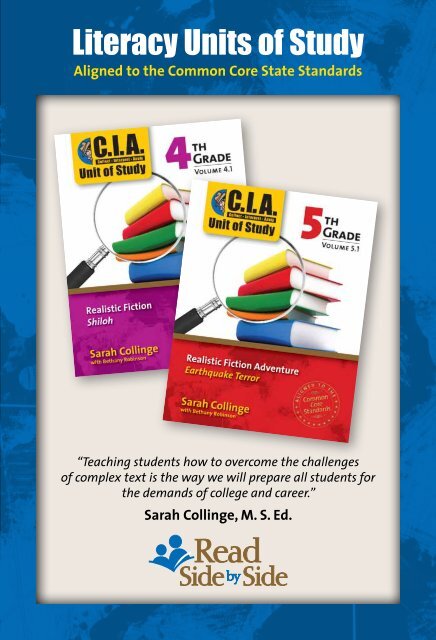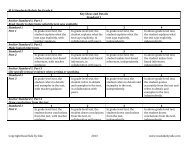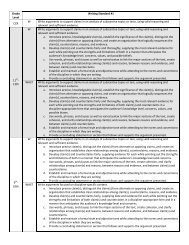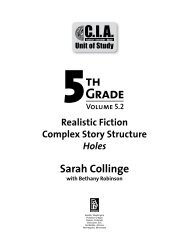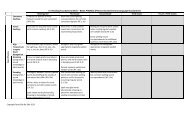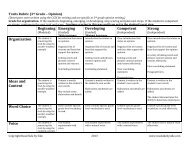C.I.A. Brochure - Read Side By Side
C.I.A. Brochure - Read Side By Side
C.I.A. Brochure - Read Side By Side
Create successful ePaper yourself
Turn your PDF publications into a flip-book with our unique Google optimized e-Paper software.
The C. I. A. Approach Providesthe Required Instructional ShiftsA fourth/fifth grade student receiving C. I. A. grade-levelinstruction during the read-aloud block will…#1 Move up Bloom’s Taxonomy while reading by applyingthe stages of C. I. A. – Collect, Interpret, and Apply.#2 <strong>Read</strong> at least 5 grade-level complex texts incollaboration with others, spending an average of9,675 minutes in rich text.#3 Know and use over 120 grade-level vocabulary wordsnecessary for accessing complex literature.#4 Analyze over 20 additional texts including maps,charts, journals, poetry, and song that supportintertextual connections across science, social studies,and the arts.#5 Share thinking and support thinking with textualevidence in over 175 partner conversations supportedby sentence stems.#6 Record over 55 pages of notes in response to reading,write an average of 10 summaries, 25 short writingpieces, 5 formal writing pieces, and defend their ownopinion in writing at least 15 times.
The C. I. A. Approach<strong>Read</strong>ers begin by dividing the text into four quadrants,then apply unique strategies in each quadrant.CCollect criticalinformationIInterpretthe textAApply toyour lifeDuring thisquadrant of thetext readers• Name the importantcharactersand infercharacter traits.• Name andvisualize thesetting.• Think about theproblem andimportantevents.• Use comprehensionstrategiesto monitorcomprehension.Duringthis quadrantof thetext readers• Use comprehensionstrategies toget to deeperthinking.• Recognizekey repeatedwords/phrases.• Start to thinkabout possiblelines ofthinking.Duringthis quadrantof thetext readers• Look forevidence tosupport aline ofthinking.During thisquadrant of thetext readers• Continue to lookfor evidence tosupport a line ofthinking.• Confirm andrevisepredictions.• Think aboutproblems/solutions/results.• Evaluate how theauthor ties up allthe loose ends.• Consider how thebook will impacttheir lives.<strong>Read</strong>ers readslowly and oftenreread.<strong>Read</strong>ersincrease theirspeed a littlebit, and rereadless.<strong>Read</strong>ersincreasetheir speedeven more andrarely, if ever,reread.<strong>Read</strong>ers readwithout interruptionto the end.At the endof the first quarter,readers stopand summarizein order to checkcomprehensionand make sure theyhave the story intheir heads.At theend of the 2ndquarter, readersstop andname a line ofthinking.At theend of the3rd quarter,readers findthe turningpoint andconsider howthe turningpoint revealsthe author’smessage. Here,readers predicthow the bookwill end.At the end ofthe book, readersconfirm or rejecttheir predictionsand evaluate theauthor’s ending.Then readers reflecton their readingby summarizingand synthesizingthe text. Finally,they evaluate theauthor’s message.
4 th Grade Units of StudyGenreRealistic FictionEpic FantasyBiographyHistorical NonfictionHistorical FictionTitle & AuthorShilohPhyllis Reynolds NaylorThe Castle in the AtticElizabeth WinthropStreams to the River, River to the SeaScott O’DellChildren of the Gold RushClaire Rudolph Murphy & Jane G. HaighThe Gold Rush KidMary Waldorf5 th Grade Units of StudyGenreRealistic Fiction —AdventureRealistic FictionHistorical FictionNonfictionScience FictionTitle & AuthorEarthquake TerrorPeg KehretHolesLouis SacharChainsLaurie Halse AndersonKids at WorkRussell FreedmanThe City of EmberJeanne DuPrau“The C. I. A. approach is a research-based approach to reading comprehension that has resultedin various success stories. There is no other process that utilizes and combines numerous readingstrategies, including read-aloud, guided reading, book clubs, partnerships, conferences and writingassignments in order to meet the needs of students on all reading levels. Through this program,teachers can learn how to change the ways their students read for the better.”~Kathryn, Literacy Expert, Plus Plus Tutoring
Samples of Student WorkStudents practice grade level vocabulary and expand word knowledge.
Samples of Student WorkStudents use speaking and writing stems to synthesize and extend their thinking.
<strong>Read</strong><strong>Side</strong> by <strong>Side</strong>Literacy Publications & Consulting<strong>Read</strong> <strong>Side</strong> by <strong>Side</strong> offers seminars, workshops, consulting,and coaching to schools throughout the United States. EmailSarah Collinge to invite us to your building, district, or region —sarah@readsidebyside.com.Raising the Standards through Chapter Books:The C. I. A. Approach. This book gives you an in-depthunderstanding of the C. I. A. approach. Sarah Collingeintroduces teachers to a new approach to readingchapter books that motivates students by bridgingthe gap between text and reader. The acronymC. I. A. stands for collect, interpret, and apply—theessential components of the approach. <strong>By</strong> breakingdown the reading process into meaningful stages,Sarah brilliantly simplifies the overwhelmingtask of reading longer, more complex text. Whilemaking the process of reading explicit, the approachincreases the cognitive capacities of all readers,whether they are below, at, or above grade level.Sarah Collinge has taught in intermediateclassrooms for eleven years and has also servedas a literacy coach in classrooms K–6. She is nowa literacy consultant for <strong>Read</strong> <strong>Side</strong> by <strong>Side</strong> Corp.,working in schools across Washington State. Sarahholds a Masters in Literacy Instruction.Order materials here:www.readsidebyside.com


